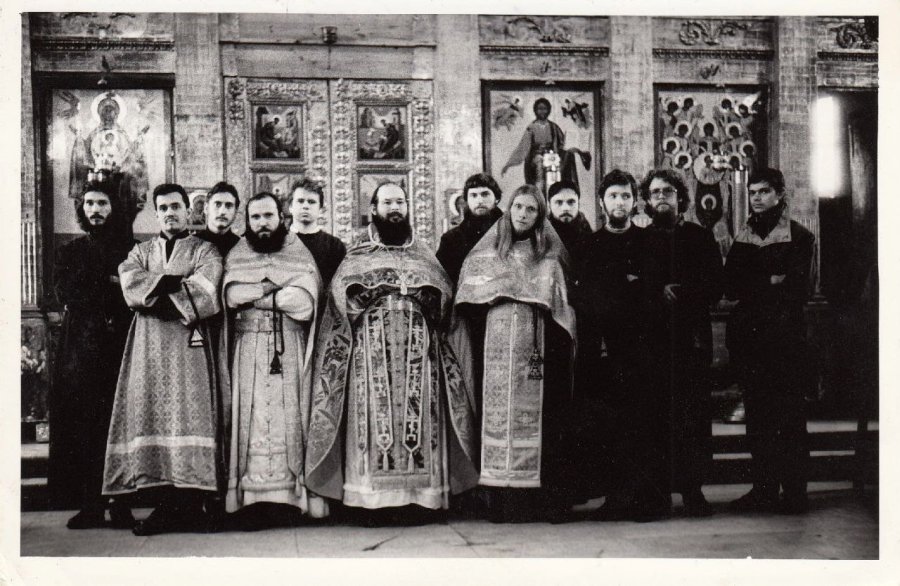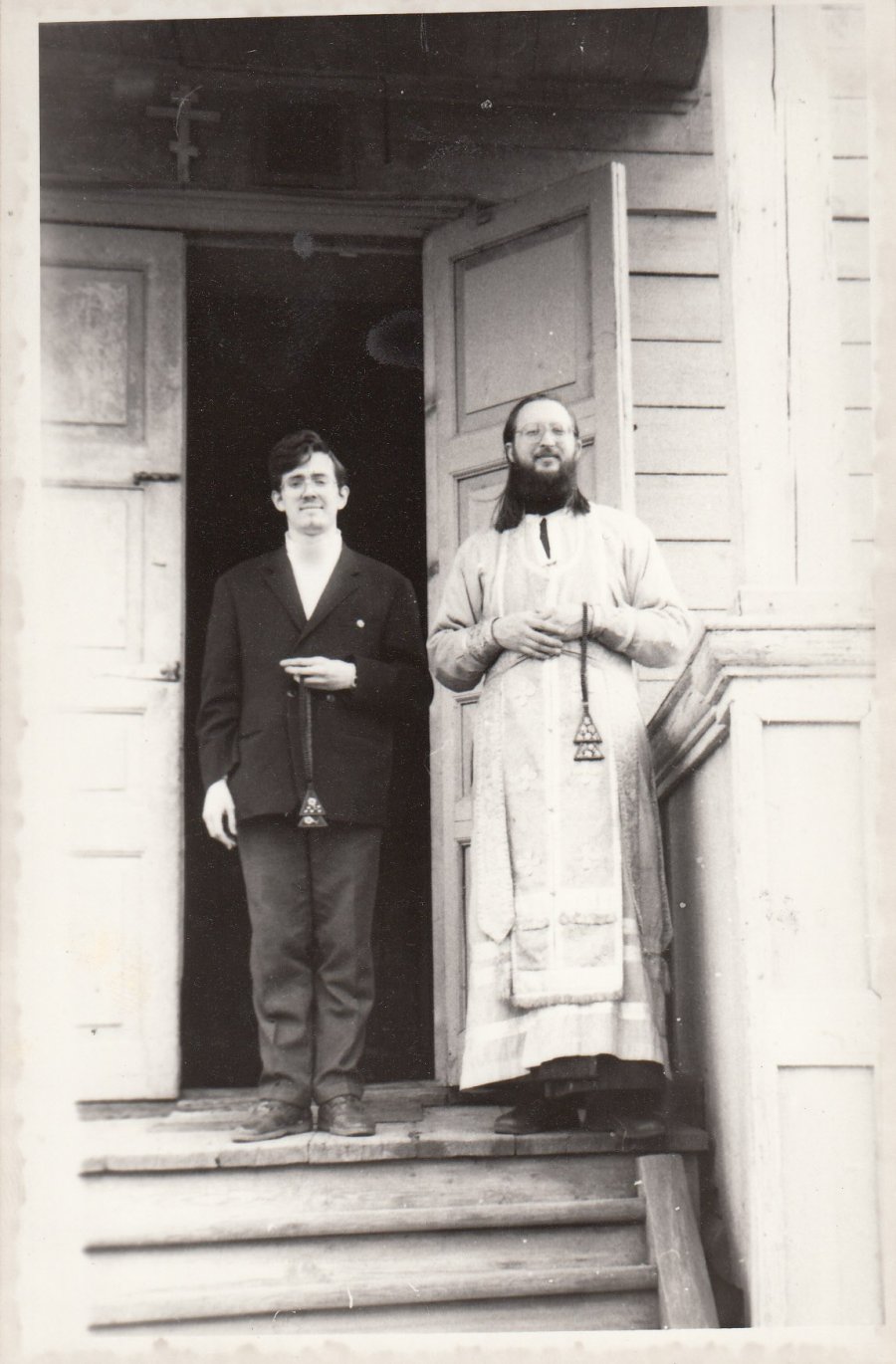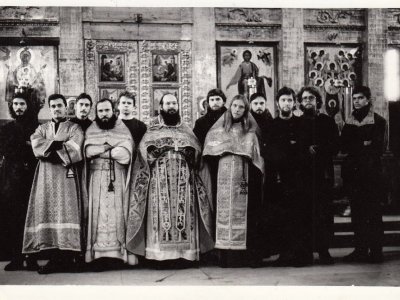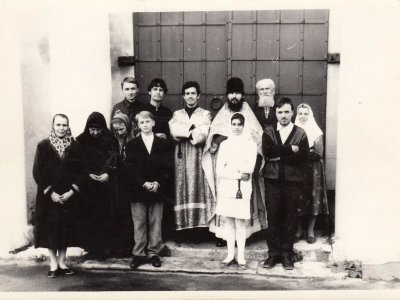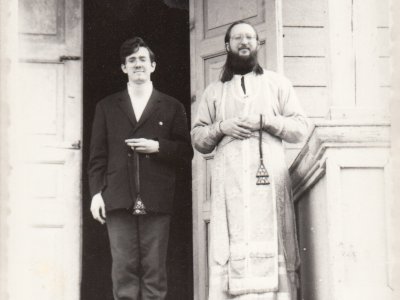In memory of reader Dimitri Furtsev we present to you his article on Edinoverie which was delivered at the VI World Russian People's Council in 2001.
"The Old Rite is a treasury of the Church's Orthodox culture. It is not just a tribute to the national past; it is the continuity of the roots, the purity of Ecumenical Orthodoxy, the pure Faith of Christ in all its fullness and greatness."
Dmitry Furtsev, Reader,
of the Edinoverie Church of St. Michael the Archangel (Mikhailovksaya Sloboda),
member of the Political Council of the "Eurasia" Movement
The Historical and Spiritual Meaning of Edinoverie
I would like to begin my brief presentation on the subject of Edinoverie by thanking the organizers of such a momentous event-the VI World Russian People's Council, the leadership of the Russian Orthodox Church-Moscow Patriarchate, and personally the chairman of this section, His Eminence Vladyka Kirill, for inviting me to speak at such a high-profile gathering. Let me also express my sincere gratitude to Alexander Dugin, who helped me greatly in compiling this report.
A critique of the thesis of progress
We are too impregnated with a secular upbringing today to adequately understand matters of religion. We take progress for granted. And our attitude toward antiquity is not as an assimilation of ready and not subject to revision of the final judgment.
From the sociological point of view, the Russian Raskol marks the transition of Russia from traditional society to post-traditional society, from Holy Russia to secular Russia, from the Moscow period to the St. Petersburg period, from a perfect identity to an alignment with Europe. The Eurasianists of the 1920s, with their characteristic maximalism, spoke of a "bicentennial Romano-Germanic yoke". Moscow Russia - pre-Raskolk Russia - was based on the closest symphony between the Faith and the State, between society and the Church. Such an indissoluble fusion of Faith and Authority is characteristic of the entire Byzantine period, and in this is the essential difference between Eastern Christianity and Western Christianity. I recall that in Orthodox doctrine, according to the interpretation of St. John Chrysostom and other holy fathers, the passage from St. Paul's second letter to the Thessalonians concerning the eschatological function of the "catekhon", the "keeper" whose existence prevents the arrival of the "son of perdition", the Antichrist, was unequivocally interpreted as describing the sacred function of the Emperor as head of the Orthodox Empire. This was the eschatological meaning of the symphony of powers--the Orthodox Basileus is the key figure of sacred history as Christianity understands it. Extending this thought, we get a uniquely Eastern Christian understanding of the soteriological nature of the State, of power, of the social order. We can say that in a sense the "Two Cities" of which Blessed Augustine wrote, in the Byzantine understanding of symphony partly merge, converge, whereas Catholicism and even more so later Protestantism, on the contrary, separate them as far apart as possible.
Old Rus', brought up in this Byzantine spirit, fully understands the meaning of symphonia precisely when Constantinople falls, which was interpreted by the Russians as payment for the Florentine Union. Metropolitan Isidore's expulsion from Moscow was the historical expression of this unanimous historiosophic diagnosis. From St. Gennady of Novgorod and Venerable Joseph of Volokolamsk to the final formulation of St. Philotheus on Moscow-Third Rome, Russia enters into the rights of the full eschatological heritage of "catekhon". And it is the Statehood and the figure of the Tsar that take on special significance. The coronation of Ivan the Terrible as heir to the line of Byzantine emperors, the establishment of the Russian patriarchate, this translatio imperii was not a simple national isolation, but the triumph of the merger of sacred statehood, headed by the Catekhon-tzar and the Orthodox Church. Muscovite Russia has realized itself not just an independent Orthodox country, but the core and the last stronghold of Orthodox civilization, the pole of sacred socio-religious formation, radically different not only from non-Christian believers or heretics "Latins and Lutherans", but - and this for us is crucial - and from the Orthodox Greeks, who with the loss of state independence lost its catekhonic value, symphonic principle, turning from the core of civilization into a split reality of narrowly religious.
Moscow inherits the sanctity of the State. And the rite received from the Greeks is seen not as a national adaptation of the original, but as a seal of preservation of "Orthodox antiquity", dating back to the era when Byzantium was symphonic, and Basileus was a full-fledged catekhon. After the fall of Constantinople, this catekhonic epoch was providentially prolonged in Russia, hence the sanctity of the Russian Tzardom was perceived inseparably from the Russian church rite, whose peculiarity and uniqueness was realized - for example by St. Maximus the Greek or later by Zakharia Kopystensky - as a direct continuation of Byzantism, but still undefiled, full, symphonic and "catekhnical".
The post-Raskol period produces a new state and a new church.
The catastrophic nature of Raskol consisted in the desacralization, scientifically speaking, of society, the state, and the entire social order of Russia. Striking a blow to the old rite, Patriarch Nikon and the activists of the Council of 1666-1667 got into the middle of the church-state synthesis, denouncing Holy Russia, equating it to an ordinary country professing Orthodoxy, but only as a religion-as, indeed, the Greeks themselves, who by that time were already living for two centuries under the rule of Turkish heterodox authorities. The oaths imposed on the old rite and the decisions of the Stoglav, which canonically cast the catekhonic national-universal idea of the Third Rome, were a verdict on the Russian antiquity and Orthodox antiquity, and, accordingly, the end of a full-fledged church-state synthesis. This was quite realized by supporters of Old Believers, who perceived the "corruption of the faith" as the fall of all of Holy Russia, as "withdrawal from the environment of the catekhon", as the arrival of the Antichrist.
Of course, it was a maximalist reaction, but it reflected very deep attitudes of a deeply Orthodox understanding of the logic of sacred history, the function of the rite and the sanctity of the state, the soteriological role of the Autocrat. The disputes over the adequacy of the old rite, so simply resolved by E. E. Golubinsky, were summed up in the remarkable book of V. V. Zenkovsky's History of Old-Ritualism.
Henceforth there was in Russia a principally new power, and if you will, - a new Faith, because at this very moment the Orthodox Church becomes a "religion" approximately in the sense as this term was understood in the Christian West, while previously, being inseparably united with the sacred kingdom, it was something much wider and more all-embracing, more integral and total. The facade has remained intact; the content has changed considerably. The reforms of Peter the Great and subsequent Russian history, especially the excesses of the 17th century during the reign of Anna Ioannovna, showed that the Old Believers' fears were correct: Russia left its past, began to think and dress differently, pray differently, speak differently, govern differently. Undoubtedly, this was a significant step in the direction of the West. And thus, away from Muscovite Russia, a radical step from antiquity to modernity, from roots to newness. The indiscriminate spread of Ukrainian elements among the clergy and especially among the bishops underscored this process and its importance. Unlike the Great Russians, the Little Russians had long been in close contact and under a certain influence of the European spirit in the church sphere, from Uniatism to Catholicism and (to a lesser extent) Lutheranism.
The post-Raskol period of Russian history has several phases. Paradoxically, the nineteenth century is in many ways more conservative and old than the eighteenth. "Starchestvo" is formed again in Russia, in certain circles of the nobility, later intellectuals, the interest in antiquity, to the roots awakens. Slavophiles raise the idea of the identity of Russian civilization.
This also affects the symbolic side of church life. Eight-pointed cross returns to us, equated since the end of the XVII century to the "attribute of schismatic Brynsk faith," aristocracy again does not bend to wear a once "forbidden" beards, the remnants of ancient folk life is lovingly studied and recorded. Both the right (Slavophiles) and the left (Narodniks - in particular V.I. Kelsiev, as well as A.I. Herzen himself) show interest in old-believers. P.I. Melnikov-Pechersky, who at the beginning was a persecutor of Kerzhenets, writes inspired epics about Old Believers.
Stages of going back to the old rite
And what is the present state of affairs with regard to the Old Rite? The Venerable Vladyka Kirill has very precisely formulated that the Russian Orthodox Church has two parts of its spiritual heritage-not only the New Believer Nikonian lineage, but also the heritage of pre-Nikon Russia.
The rehabilitation of the Old Faith took place in several stages. In 1800 (the date is significant in confirming our assumption about the more conservative character of the nineteenth century compared with the eighteenth), Edinoverie was established by Metropolitan Platon. This was a serious step in the direction to the old rite. It was no longer considered rigidly "heretical," but rather minority, permissible in exceptional cases, which implied already its mystical "equality," though with great reservations.
An unfortunate episode in the history of Edinoverie during the reign of Nicholas I, when the Old Believers were driven into Edinoverie by force, greatly overshadowed this endeavor.
At the Local Council of 1917-1918, the question of reviewing the attitude to the Old Believers was again raised. In the preparatory materials there are proposals for a complete rehabilitation of the Old Rite. But the exceptionality of the moment did not allow to complete what was started.
The next stage is the 1929 Resolution of the Holy Synod of the Russian Orthodox Church on the abolition of "oaths" i.e. anathemas (at the time Metropolitan Sergius (Stragorodsky) was the Locum Tenens of the Patriarchal Throne). This document, very important for Russian Orthodoxy, contains recognition of the full and complete equality of the old rite, takes off the oaths from the Old Believers and declares the resolutions of the Council of 1666-1667 invalid. It is indicative that with regard to the decrees of this Council the document uses the same expression - "to impute as not having been" - as its organizers did with regard to the "Stoglav". Thus, it was in 1929, in the heyday of Soviet power, that Holy Russia was rehabilitated in ecclesiastical terms for the first time in 300 years! Bishop Andrew (Ukhtomsky) of Ufa, a staunch proponent of Edinoverie, notes that the 1929 Resolution of the Holy Synod passed virtually unnoticed, and even its creators did not take it seriously, but it is difficult to overestimate the importance of this step.
In 1971 the Local Council of the Russian Orthodox Church once again returned to this subject, and the main points of the 1929 Resolution of the Holy Synod rehabilitating the old rite and the old faith were fully confirmed and reinforced by the authority of the Council. Today, this subject of the return of the lost, forgotten heritage-the second half of Russian Orthodoxy (in the happy expression of Venerable Vladyka Kirill)-is once again on the agenda. Thus in November 2000 a solemn celebration of the 200-year anniversary of the establishment of Edinoverie took place in the Kremlin in the presence of His Holiness Patriarch Alexy II of Moscow and All Russia. It is symbolic - once again, in our difficult time on the threshold of an anxious millennium, we are turning to our roots.
On the advantages of the old rite
The Old Rite is a treasury of the Church's Orthodox culture.
It is also the solemn structure of Znamenny chant, hooks.
It is the fullness of long church services, where not a single element is omitted, not a single line or homily is abbreviated.
It is also the obligation of Russian dresses, sundresses and caftans.
It is a revival of the unique old icon painting.
It is the old Russian communality, the custom of electing priests by the parishioners.
It is a deep and full-blooded participation of all the laity in the divine service, the strict decorum of bows and the signs of the cross.
It is the old two finger sign of the cross.
It is the lovingly crafted lestovkas and podruchniks.
It is the distinctive old piety that, in spite of all the liberal indulgences, makes (at times forcibly) every Christian keep to the human form.
It is the ascetic deeds of Mariino stoyanie with countless ground prostrations that purify the soul and body in the sorrowful days of Lent.
It is the amazing teachings of the Fathers, which contain revelations, unexpected for our contemporaries, of the faith we have lost in the transfiguring miracle and examples of unimaginable spiritual fortitude.
It is a living sense of the future rebirth, the integral element of the eternal life of the human soul, for which bodily death is not the end of everything, but only a new beginning.
It is the Old Believer responsibility for words and deeds, masculine, strong-willed character.
It is the all-round sanctification of everyday life - work, food, clothing, household, holidays, weekdays.
It is the integral element of complete, sanctified - both in faith and in life - Orthodox life.
It is not just a tribute to the national past, it is the continuity of the roots, the purity of Ecumenical Orthodoxy, the pure Faith of Christ in all its fullness and greatness.
The great return
The return of the old rite, the full-blooded restoration of Edinoverie, this second, forgotten, almost lost part of the Church, is an important and momentous historical choice. Thus, in essence, we are returning to our foundations, restoring the fullness of tradition, turning spiritually to the heights of the faith of the fathers. Edinoverie, the restoration of the old rite, is not simply a cultic, ritualistic, purely intra-church process. The movement in this direction opens up to us completely new horizons of national state social life as compared to those of today.
In essence, with this gesture we are once again turning to Holy Russia, calling up its forgotten spirit that has been hidden from us. And this affects all parameters of our existence. Including the relationship between the State and the Church. The spirit of the Muscovite Tzarodom, the Third Rome is the spirit of full symphony, inseparable unity, synthesis of Faith and Power, State and Church, clergy and laity, people and civilization, spirit and flesh. It is an orientation toward restoring the lost wholeness and sanctity of being, toward giving our spiritual tradition a full-fledged social dimension.
Such a loving, trusting, attentive attitude toward the past is much more in keeping with the Orthodox attitude, in my opinion, than the superficial and impudent contempt for the past of the proponents of "progress".
To summarize: in Edinoverie I see not only paying tribute to history, not only the belated correction of fatal mistakes. This is also a pledge of a new way, a new stage in the existence of the Russian people, the Russian state, the Russian Church. This is a great return to the eternal source.
Overcoming the Raskol, we will join the two most important parts, of which is woven the high destiny of us, the Russians. And may God help us on this difficult and glorious path.
The Russian Orthodox Church in the Space of Eurasia. - Materials of the VI World Russian People's Council. - The Russian Orthodox Church in Eurasia. - М., 2002. - С.67-74.
